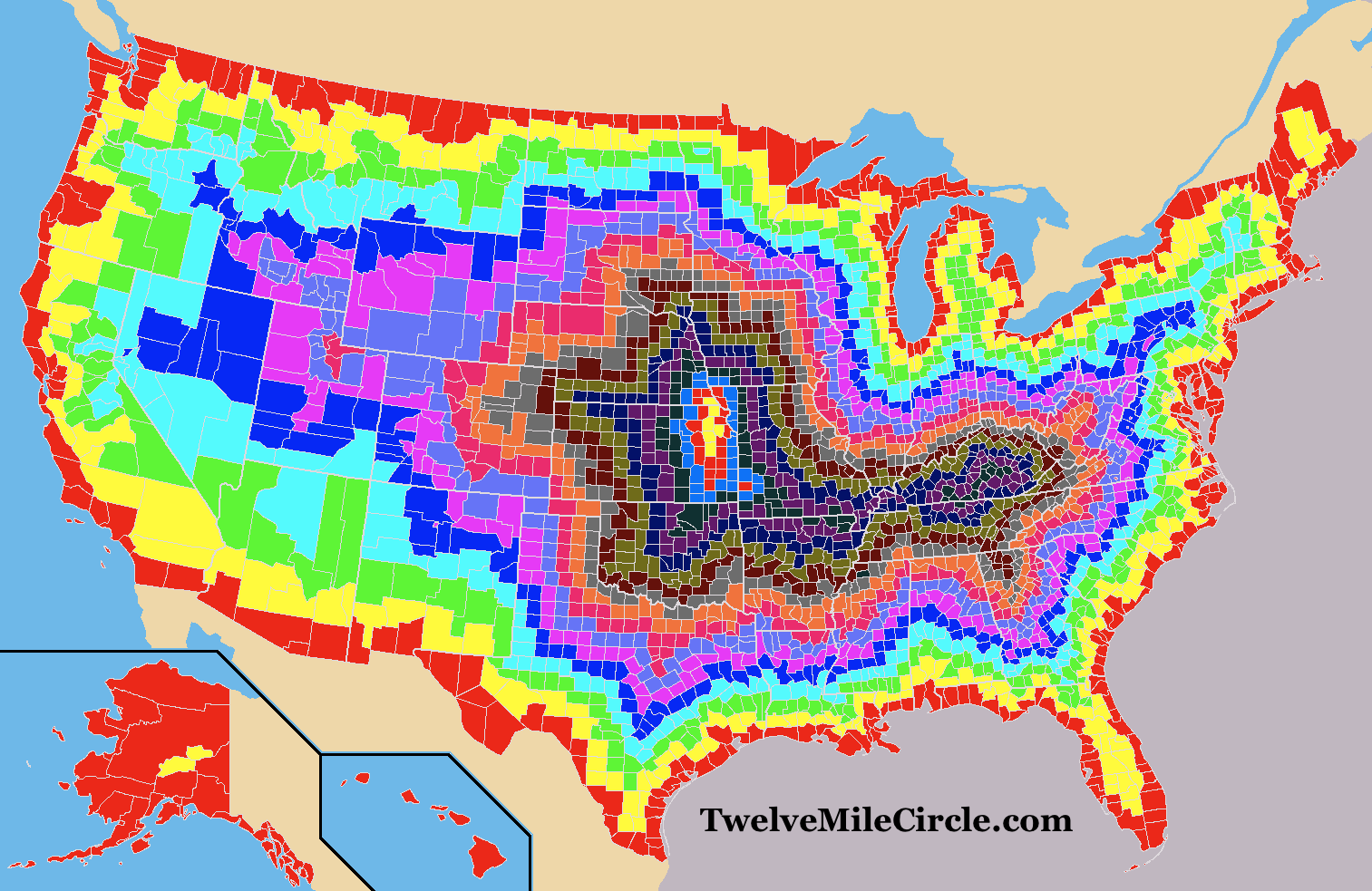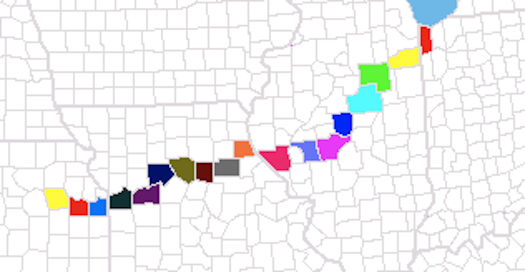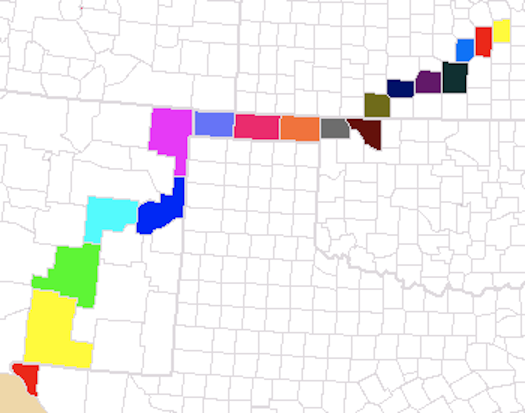I left some unfinished business behind a few weeks ago with the Layers of Borderlocking article and it has continued to gnaw at me. As you may recall, I figured that someone standing within the boundaries of the United States would never have to travel through more than seventeen counties (eighteen if one counts the starting point) to exit the nation. Someone doing this could — and probably would — cross into many more than than seventeen for all kinds of practical reasons but it’s not a mandatory requirement.
Theoretical vs. Practical

I further speculated that this was perhaps more theoretical than practical unless someone undertook the journey by foot. That would allow our intrepid trekker to jump diagonally between the many counties that intersect at quadripoints like a game of checkers. He would still have to contend with rivers, mountains, deserts and other obstacles but he could succeed with sufficient determination.
I’ve not seen evidence that anyone has ever done this before so maybe a history-setting challenge would provide enough incentive. Someone traveling by motor vehicle would make better progress but the effort would likely fail because the road and rail grids aren’t aligned with my silly little theory of minimal county paths.
Nonetheless I wondered if there might be some way, any way, that a person could start from within one of the six most completely borderlocked counties and reach the edge of the nation by automobile, touching only seventeen other counties. I’ve pondered, searched, measured, mapped and worked through dozens of possibilities. The answer seems to be a resounding YES.
A Great Lakes Escape
The counties align particularly favorably from the middle towards the east-northeast in the direction of Lake Michigan. Quadripoints do exist but they can be avoided. Sufficient off-set between counties generally provides for flexible routing. The Mississippi River presents a significant obstacle because bridges are scarce but counties lacking crossings can be avoided easily enough.
The Path
Here is one path out of many.

I selected this one for its sightseeing potential. It’s a road trip that I might actually want to try someday. The path stretches from Topeka, Kansas to Gary, Indiana. Normally it would take about nine and a half hours to cover about 575 miles along Interstate highway. A minimal county route would add another fifty miles of distance but increase the driving time but about three more hours. That’s not so bad considering the very special conditions that must be met.
You’ll have to trust me that this is a minimal county path until Google adds a county layer to its maps. I had to toggle back-and-forth between Google Maps and Mapquest to plot this route. I considered using Mapquest but it’s ability to handle alternate paths lacked sufficient precision to deal with the complexity of my solution. Google Maps has some issues too, as you’ll see in a moment, but it still provided much greater flexibility for my intended purpose. If only a mapping service supplied the best features of both.
The Counties
Again, the path travels through seventeen counties, for a total of eighteen counties when one counts the point of origination:
(1) Shawnee Co., KS
(2) Douglas Co., KS
(3) Johnson Co., KS
(4) Jackson Co., MO
(5) Lafayette Co., MO
(6) Carroll Co., MO
(7) Chariton Co., MO
(8) Randolph Co., MO
(9) Monroe Co., MO
(10) Marion Co., MO
(11) Pike Co., IL
(12) Morgan Co., IL
(13) Sangamon Co., IL
(14) Logan Co., IL
(15) McLean Co., IL
(16) Livingston Co., IL
(17) Kankakee Co., IL
(18) Lake Co., IN
It travels through two State capitals (Topeka in Shawnee Co. and Springfield in Sangamon Co.), through a major college town (KU — the University of Kansas in Douglas Co.), past the Kansas City suburbs, and over the Mississippi River into Mark Twain country (Hannibal in Marion Co.).
Some will note — and they have a valid point — that Lake Michigan should not be considered a proper solution. I say it’s “close enough” since any body of water large enough for ships as massive as the Great Lakes freighters should qualify as a successful escape route. Nonetheless I can’t deny that one would have to cross through the territorial waters of several other counties.
Therefore, while I think it’s a perfectly fine solution I recognized that many others would consider it sub-optimal at best.
Escape via Ol’ Mexico
That got me to search for alternate paths that did not involve Lake Michigan and that’s where the real fun began. I had just about given up after numerous dead-ends and fruitless searches until I finally found one.
The Path

This path travels from Osage City, Kansas to El Paso, Texas, and should be much more palatable to those who follow the most strict of definitions. The little tan shaded area at the bottom-left corner of this image is Mexico for those of you wondering about a mysterious “nineteenth” shaded shape.
It’s deliciously inefficient. One should be able to travel between the two points along an 850 mile path in about fourteen hours. However, follow the minimal county route and add another hundred miles plus another four and a half hours behind the wheel.
I also need to note that I’ve included one inaccuracy located between the towns of Vaughn and Corono in New Mexico. I couldn’t snap the route properly to the road grid because, apparently, Google has a bias against dirt roads. These are genuine roads with actual county road designations so it should be possible to pass through here in a standard automobile.
When looking at the map, consider the line between Vaughn and Corono as the hypotenuse, with the two remaining sides of the triangle towards the southeast formed by very minor roads as the actual route.
The Counties
With that one caveat, here is the solution.
(1) Osage Co., KS
(2) Lyon Co., KS
(3) Chase Co., KS
(4) Butler Co., KS
(5) Sedgwick Co., KS
(6) Kingman Co., KS
(7) Barber Co., KS
(8) Woods Co., OK
(9) Harper Co., OK
(10) Beaver Co., OK
(11) Texas Co., OK
(12) Cimarron Co., OK
(13) Union Co., NM
(14) Quay Co., NM
(15) Guadalupe Co., NM
(16) Lincoln Co., NM
(17) Otero Co., NM
(18) El Paso Co., TX
Can anyone find a seventeen-step solution to the Atlantic Ocean, Pacific Ocean or Gulf of Mexico? I didn’t have any luck but I started losing interest once I found the Mexican solution.

Leave a Reply